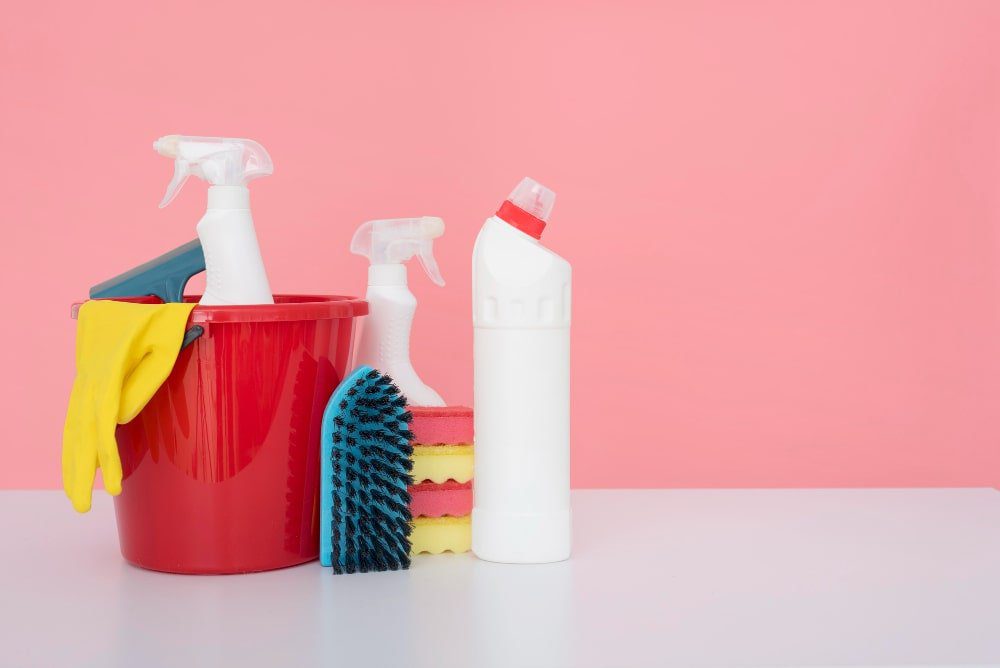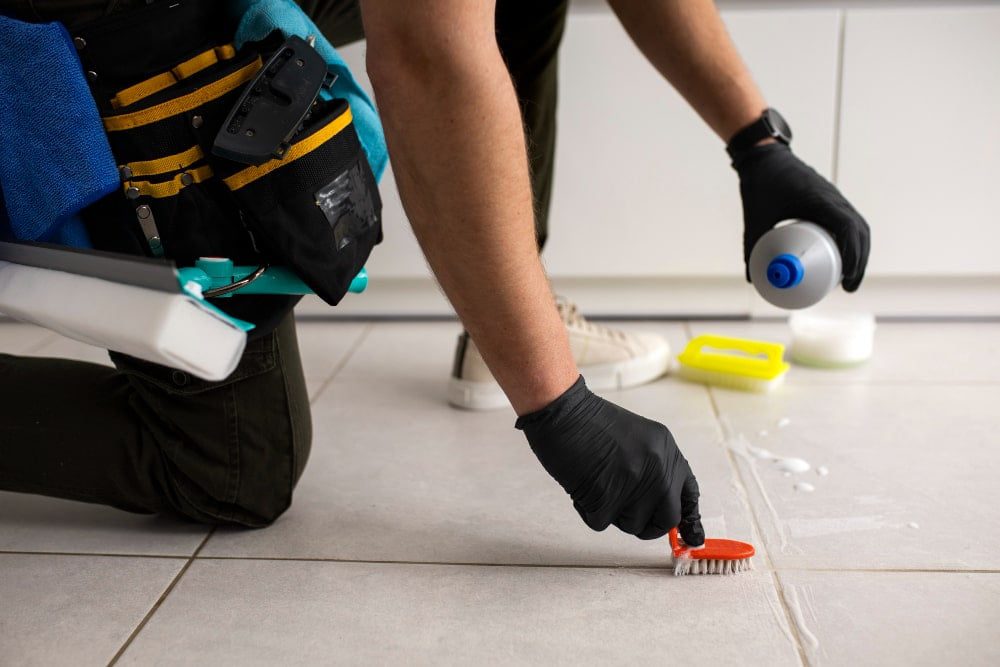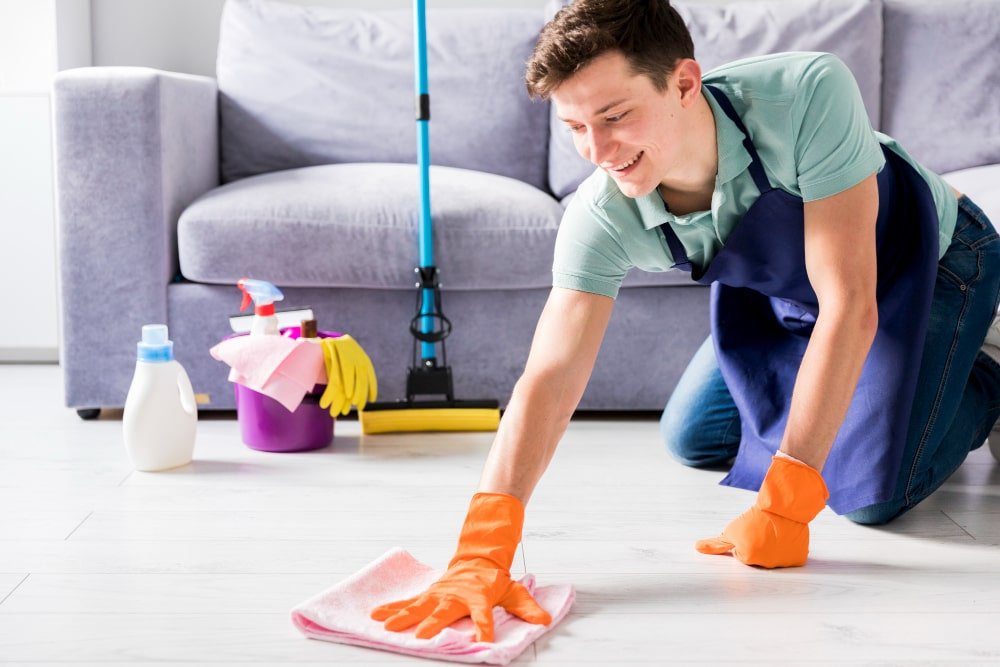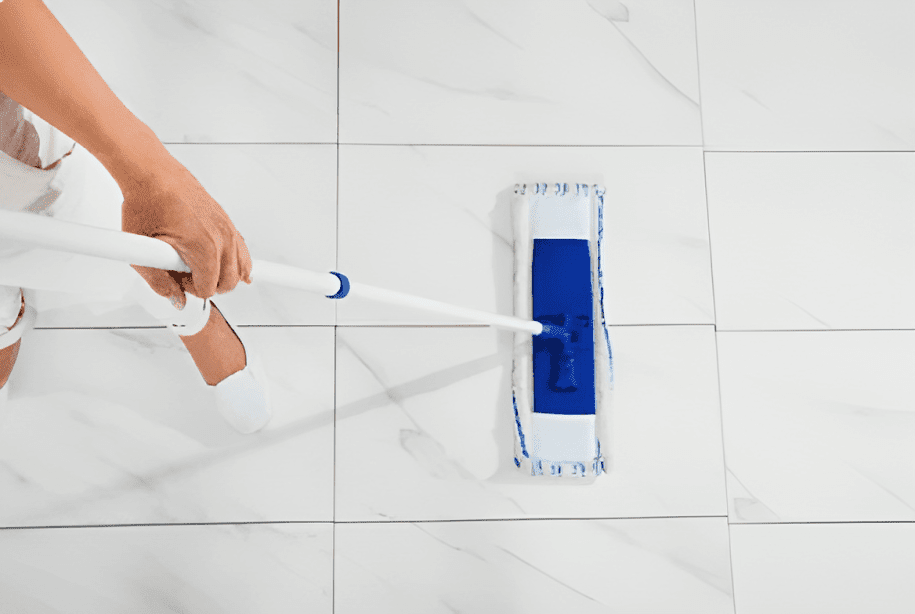Dirty tile floors can be a source of frustration and embarrassment for homeowners. Over time, grime, stains, and accumulated dirt can mar the appearance of your tiles. Fortunately, with the right cleaning approach, you can restore the shine and cleanliness of your tile floors. In this guide, we’ll explore effective methods to achieve sparkling clean tile floors, ensuring your home looks its best.
Gather the Supplies

Before you begin the task of cleaning your tile floors, it’s essential to gather the necessary supplies. Having the right tools and cleaning agents on hand will make the process more efficient and effective. Here’s a list of items you’ll need:
- Mop: A good-quality mop will be your primary cleaning tool. Choose one with a reusable and washable mop head for eco-friendliness.
- Bucket: You’ll need a bucket to mix your cleaning solution and rinse the mop.
- Scrub Brush: A scrub brush with soft bristles is useful for tackling stubborn stains or grout lines that need extra attention.
- Mild Detergent: Opt for a mild, pH-neutral detergent. Avoid harsh chemicals that could damage your tiles or grout.
- Vinegar: White vinegar is an excellent natural cleaning agent that can help remove dirt and stains.
- Baking Soda: Baking soda is another versatile and natural cleaning agent that works well on tile floors.
- Water: You’ll need clean, lukewarm water for mixing your cleaning solution and for rinsing.
- Microfiber Cloths: These are handy for wiping down surfaces and ensuring a streak-free finish.
- Old Towels or Rags: Keep some old towels or rags nearby to clean up any spills or excess water.
- Protective Gear: Consider wearing gloves to protect your hands, especially if you’re using cleaning agents. Also, wear comfortable clothing that you don’t mind getting dirty.
By having these supplies ready before you start, you’ll be well-prepared to tackle the task of cleaning your tile floors effectively and efficiently.
Preparing the Tile Surface

Before you begin the actual cleaning process, preparing the tile surface is a crucial step. Proper preparation ensures that the cleaning agents can work effectively and helps in achieving the desired cleanliness for your tile floors. Follow these steps to prepare the tile surface:
- Remove Surface Debris: Start by removing any loose debris, dust, or dirt from the tile surface. You can use a broom, a vacuum cleaner, or a dust mop for this purpose. Pay special attention to corners and edges where dirt tends to accumulate.
- Sweep or Vacuum: Use a broom or a vacuum cleaner to thoroughly sweep or vacuum the entire area. This helps in getting rid of larger debris and prepares the surface for a deeper clean.
- Clear the Area: Remove any furniture, rugs, or obstacles from the area you’re planning to clean. This provides you with unrestricted access to the entire floor and allows for a thorough cleaning.
- Protect Delicate Surfaces: If there are delicate surfaces or objects nearby that could be affected by the cleaning solution, consider placing protective coverings or moving them to a safe location.
- Pre-Wet the Surface: Before applying any cleaning solution, pre-wet the tile surface with water. Use a mop or a clean cloth dampened with water and go over the floor. This helps in loosening some of the grime and makes the cleaning process more effective.
- Check for Stains: Identify any noticeable stains or spots on the tiles. Note their location and intensity as you’ll need to give extra attention to these areas during the cleaning process.
By adequately preparing the tile surface, you set the stage for a successful cleaning process. This ensures that the cleaning agents can work optimally, resulting in sparkling clean tile floors.
Clean a Dirty Tile Floor with Baking Soda

Cleaning your tile floors with baking soda is an effective and natural method that can restore the shine and cleanliness of your tiles. Here’s a step-by-step guide on how to clean your dirty tile floor using baking soda:
- Gather Your Supplies:
- Baking Soda
- Warm Water
- Mop or Soft Brush
- Bucket
- Prepare the Cleaning Solution:
- In a bucket, mix a half cup to a cup of baking soda with warm water to create a thick, spreadable paste.
- Apply the Baking Soda Paste:
- Take the paste and spread it evenly across the dirty tile floor, ensuring that the grout lines are well-covered. Focus on areas with stains or discoloration.
- Let it Sit:
- Allow the baking soda paste to sit on the tiles and grout for at least 15-20 minutes. This time allows the baking soda to penetrate and loosen dirt and stains.
- Scrub the Grout and Tiles:
- Use a soft brush or an old toothbrush to scrub the grout lines gently. For the tiles, use a mop or a soft-bristled brush to scrub the surface, paying extra attention to any tough stains.
- Rinse Thoroughly:
- After scrubbing, rinse the floor thoroughly with clean water to remove the baking soda and the dirt it has lifted.
- Inspect for Remaining Stains:
- Check if any stains persist. If needed, repeat the process in the affected areas.
- Dry the Floor:
- Use a clean, dry towel or mop to remove excess water from the floor, leaving it to air dry.
- Final Touches:
- Optionally, for added shine, you can dampen a clean mop with water and a splash of vinegar. Gently mop the floor to leave a streak-free finish.
- Regular Maintenance:
- Maintain the cleanliness of your tile floors by performing this baking soda cleaning method regularly or as needed.
Cleaning your tile floor with baking soda is a cost-effective and eco-friendly way to maintain the beauty of your flooring. It’s gentle yet effective in lifting stains and grime, leaving your tiles looking refreshed and revitalized.
Cleaning Techniques

Cleaning your tile floors involves using specific techniques to effectively remove dirt, stains, and grime. Different types of tiles may require slightly different approaches. Here are various cleaning techniques to help you achieve sparkling clean tile floors:
- Regular Mopping:
- For day-to-day cleaning, a damp mop with warm water can do wonders. Ensure the mop is not too wet, and go over the floor in sections, rinsing the mop as needed.
- Mild Detergent Solution:
- Mix a mild detergent with warm water. Use a mop or sponge to clean the tiles. Gently scrub any stubborn spots. Rinse thoroughly with clean water.
- Vinegar Solution:
- Mix equal parts of water and white vinegar to create a natural cleaning solution. Apply with a mop or sponge, then rinse with water to remove any vinegar residue.
- Baking Soda Paste:
- Create a thick paste using water and baking soda. Apply the paste to stained or dirty areas and let it sit for a while. Scrub with a soft brush and rinse with water.
- Steam Cleaning:
- Steam cleaners use hot water vapor to clean and disinfect surfaces. This method is effective for both tiles and grout, and it doesn’t require additional cleaning agents.
- Commercial Tile Cleaners:
- Use a specialized tile and grout cleaner available in the market. Follow the instructions on the product carefully for best results.
- Grout Brushing:
- Use a grout brush to specifically target grout lines. Apply a grout cleaner or a mixture of baking soda and water, then scrub gently along the grout lines.
- Hydrogen Peroxide for Stains:
- Apply hydrogen peroxide directly to stubborn stains. Let it sit for a few minutes, then scrub and rinse with water.
- Buffing:
- Use a buffing machine with a soft brush or a buffing pad to give your tiles a polished look. This can also help remove minor stains.
- Acidic Cleaners (for certain tiles):
- For tiles like ceramic or porcelain, you can use acidic cleaners to remove tough stains. However, avoid these on natural stone tiles as they can cause damage.
Choose the cleaning technique based on your tile type and the level of grime or stains. Regular maintenance and the right cleaning method will keep your tile floors looking clean and fresh.
Natural Cleaning Solutions

For those seeking eco-friendly and natural alternatives to chemical cleaners, there are several effective options using common household items. These natural solutions can clean your tile floors efficiently without compromising the environment or your health. Here are some natural cleaning solutions for your tile floors:
- Vinegar and Water Solution:
- Mix equal parts of water and white vinegar in a spray bottle. Spray the solution on your tile floor and mop as usual. The acidity of vinegar helps dissolve grime and stains.
- Baking Soda Paste:
- Create a thick paste by mixing baking soda with water. Apply the paste to stains or discolored grout, scrub gently, and rinse. Baking soda’s gentle abrasiveness aids in cleaning without scratching the tiles.
- Lemon Juice and Water:
- Lemon juice, with its citric acid, can help break down grease and stains. Mix lemon juice with water and mop your tile floor. It leaves a fresh citrus scent too!
- Hydrogen Peroxide:
- Hydrogen peroxide is effective for removing tough stains on grout. Apply it directly to the stained areas, let it sit for a while, then scrub and rinse with water.
- Tea Tree Oil Solution:
- Mix a few drops of tea tree oil with warm water. The natural antifungal and antibacterial properties of tea tree oil make it a great cleaner for tiles and grout.
- Essential Oil Infused Vinegar:
- Infuse vinegar with essential oils like lavender, tea tree, or eucalyptus. The vinegar cuts through grime, and the oils add a pleasant fragrance while also having antibacterial properties.
- Salt and Water Paste:
- Make a thick paste using salt and water. Apply it to tough stains, let it sit for a while, and then scrub and rinse. Salt’s abrasive nature aids in stain removal.
- Cornstarch and Water Paste:
- Mix cornstarch and water to form a paste. Apply it to the floor, let it dry, and then wipe it off with a damp cloth. It helps in cleaning and adding a subtle shine.
These natural solutions are not only effective in cleaning tile floors but are also gentle on the environment and your wallet. Experiment with these options to find the one that works best for your specific cleaning needs.
Addressing Grout Stains
Grout stains can mar the appearance of your tile floors, but with the right approach, you can effectively tackle them and restore the grout to its original color. Here are steps to address grout stains:
- Regular Cleaning: Begin by cleaning the grout with warm water and a mild detergent. Use a soft brush or an old toothbrush to scrub the grout gently. Often, regular cleaning can remove light surface stains.
- Baking Soda Paste: For tougher stains, make a thick paste using water and baking soda. Apply this paste to the stained grout and let it sit for about 10-15 minutes. Scrub the grout with a brush and rinse. Baking soda’s mild abrasive nature helps lift stains.
- Vinegar Solution: Mix equal parts of water and white vinegar. Apply this solution to the stained grout, and let it sit for a while. Scrub with a brush, and rinse. The vinegar’s acidity aids in removing stains.
- Hydrogen Peroxide: For stubborn stains, consider using hydrogen peroxide. Apply it directly to the stained grout, let it sit for some time, then scrub and rinse. Be cautious with colored grout, as hydrogen peroxide can lighten it.
- Oxygen Bleach: Oxygen bleach is another effective option. Follow the instructions on the product, apply it to the stained grout, and let it sit. Scrub and rinse thoroughly.
- Commercial Grout Cleaners: There are many commercial grout cleaners available. Choose one that suits your needs, follow the instructions, and apply it to the stained grout.
- Grout Pen or Sealer: If the stains persist and the grout is discolored, consider using a grout pen to color-match and cover the stains. Alternatively, applying a grout sealer can help protect against future staining.
- Professional Cleaning: For deeply ingrained or extensive grout stains, hiring a professional cleaning service specializing in tile and grout may be the best solution.
Regular maintenance and immediate action against stains will keep your grout looking clean and extend the life of your tile floors. Experiment with these methods to find the one that works best for your grout stains.
Using Professional Cleaning Services
If the task seems too daunting or time-consuming, seeking professional cleaning services is a viable option. Professional cleaners have the expertise and tools to deep clean your tile floors, leaving them looking as good as new.
Maintenance Tips
Maintaining clean tile floors requires regular attention and care. By incorporating these maintenance tips into your routine, you can prolong the life of your tiles and keep them looking fresh and beautiful for years to come:
- Regular Cleaning:
- Clean your tile floors regularly to prevent dirt and grime buildup. A quick sweep or vacuum followed by a mop with warm water will suffice for routine maintenance.
- Prompt Spill Cleanup:
- Accidents happen. Quickly clean up spills to prevent them from staining your tiles or seeping into the grout.
- Use Doormats:
- Place doormats at entrances to prevent dirt and grit from being tracked onto your tile floors. This reduces the amount of debris that can accumulate on the surface.
- Protect Tile from Furniture:
- Use furniture pads or felt protectors under heavy furniture to prevent scratching or scuffing of the tiles when moving them.
- Avoid Harsh Cleaning Products:
- Stay away from abrasive or acidic cleaners that can damage the tiles or grout. Stick to mild detergents or natural cleaning solutions.
- Regular Grout Sealing:
- Periodically seal the grout to protect it from stains and spills. This will also make future cleaning much easier.
- Sweep Before Mopping:
- Before mopping, sweep or vacuum to remove loose dirt and debris. Mopping with excessive dirt on the floor can lead to a muddy mess.
- Deep Clean Semi-Annually:
- Schedule a deep cleaning of your tile floors at least twice a year. This involves using appropriate cleaning agents or hiring professionals to ensure a thorough cleanse.
- Inspect for Damage:
- Regularly inspect your tiles for any cracks, loose tiles, or signs of damage. Address these issues promptly to prevent further deterioration.
- Avoid Excessive Water:
- While it’s important to clean with water, excess water can seep into grout lines and cause damage. Wring out your mop well before using it.
- Use Rugs in High-Traffic Areas:
- Place rugs in areas with high foot traffic or where spills are more likely to occur. This protects your tiles from wear and tear.
- Follow Manufacturer Guidelines:
- Adhere to the specific cleaning and maintenance guidelines provided by the manufacturer of your tiles for optimal care.
By following these maintenance tips, you can preserve the beauty and quality of your tile floors. Regular care and attention will ensure that they remain a stunning feature of your home for years to come.
Common Mistakes to Avoid
When it comes to cleaning tile floors, avoiding common mistakes is as crucial as employing the right techniques. Here are some prevalent errors to steer clear of for a successful tile cleaning experience.
One of the most frequent errors is using abrasive cleaners. Harsh chemicals or rough scrub brushes can scratch and damage the surface of your tiles, leaving them looking worn and dull. Another mistake is neglecting grout lines. Grout is porous and prone to staining. Overlooking regular grout cleaning can result in unsightly, discolored grout that detracts from the overall appearance of your flooring.
Using excessive water during cleaning is a significant blunder. While it may seem like more water would lead to a cleaner floor, too much moisture can seep into the grout, weakening it over time and causing it to crack or crumble. Conversely, not using enough water or using dirty mop water can leave streaks and a filmy residue on your tiles.
Often, people overlook the importance of spot testing. Before applying any cleaning solution, it’s crucial to test it in an inconspicuous area to ensure it doesn’t cause damage or discoloration. Ignoring this step may lead to irreversible harm to your tiles. Lastly, procrastination in dealing with spills and stains can worsen the problem. Letting spills sit for too long can make them harder to clean and more likely to cause permanent discoloration.
By avoiding these common mistakes, you’ll enhance the longevity and appearance of your tile floors, keeping them in top-notch condition for the long run.
Benefits of Clean Tile Floors
Maintaining clean tile floors is more than just an aesthetic preference; it’s a practice that brings about numerous benefits that impact your home, health, and overall well-being. Here are the advantages of having spotless tile floors:
- Enhanced Aesthetics: Clean tile floors instantly elevate the appearance of any space. The shine and luster of well-maintained tiles impart a fresh and inviting atmosphere to your home.
- Improved Indoor Air Quality: Regular cleaning eliminates dust, allergens, and bacteria from the tiles and grout, contributing to better air quality inside your home. This is especially beneficial for individuals with allergies or respiratory issues.
- Healthier Living Environment: Clean floors mean a healthier living environment. Bacteria, molds, and mildew can grow in the grout and corners of uncleaned tiles, posing health risks. Routine cleaning minimizes this potential hazard.
- Longer Tile Lifespan: Dirt and grime can wear down the surface of your tiles over time. Proper cleaning and maintenance can extend the lifespan of your tiles, saving you money on premature replacements.
- Easier Maintenance: Keeping your tiles consistently clean makes day-to-day maintenance a breeze. Spills and stains are easier to manage, requiring less effort and time to keep your floors looking their best.
- Preserved Property Value: Well-maintained tile floors contribute to your home’s overall value. Should you decide to sell, clean and attractive floors can leave a lasting positive impression on potential buyers.
- Cost-Effectiveness: Regular cleaning is cost-effective in the long run. Preventing extensive dirt buildup and grime means you won’t need to invest in heavy-duty cleaning or restoration processes.
- Eco-Friendly Approach: Utilizing eco-friendly cleaning solutions to maintain your tile floors ensures a sustainable and environmentally conscious cleaning regimen.
- Stain Prevention: Prompt cleaning helps prevent stains from settling into your grout or tiles. Stains, if left untreated, can be challenging to remove later.
- Saves Time and Effort: Regular maintenance and cleaning save time and effort in the long term. Quick, routine cleaning prevents the need for extensive, time-consuming cleaning sessions.
- Boosted Overall Hygiene: Clean tile floors contribute to an overall hygienic home environment. The absence of dirt and grime makes your home more comfortable and pleasant to live in.
- Positive Impression on Guests: Clean floors make a positive impression on guests and visitors, reflecting your commitment to a tidy and well-cared-for living space.
In conclusion, the benefits of clean tile floors go beyond aesthetics; they encompass health, longevity, ease of maintenance, and a sense of well-being within your home. Regular cleaning and proper care are investments that pay off in numerous ways.
Conclusion
Cleaning dirty tile floors is a manageable task with the right approach and supplies. Regular cleaning and maintenance can significantly prolong the life of your tiles and maintain the beauty of your living space. Follow the steps outlined in this guide to enjoy spotless, gleaming tile floors in your home.
FAQs on Tile Floor Cleaning
1. How often should I clean my tile floors?
Regular cleaning is essential. Aim for once a week to prevent dirt buildup and maintain the tiles’ shine.
2. Can I use bleach to clean my tile floors?
While bleach can be effective, it’s best to use mild detergents or natural solutions to avoid damaging the tiles or grout.
3. Are there specific cleaning methods for different tile types?
Yes, certain tiles may require specialized cleaning approaches. Always refer to the manufacturer’s recommendations for the best results.
4. Can I use a steam mop on tile floors?
Yes, a steam mop can be used on most tile floors. Ensure you follow the manufacturer’s guidelines and avoid using excessive steam.
5. How can I prevent grout stains in the future?
Regularly sealing the grout lines can help prevent stains. Consider resealing annually for optimal protection.
